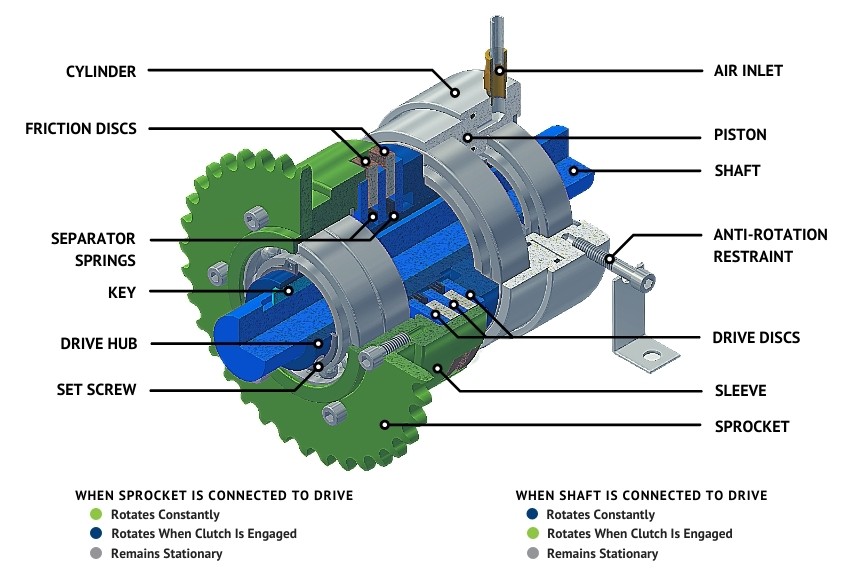How It Works: Air Engaged Friction Clutch
Mach III pneumatic clutches transmit rotary motion from a shaft which rotates constantly to a shaft that is only required to rotate intermittently. This type of clutch is engaged with air pressure and is positively disengaged by spring pressure when air pressure is absent.
BASIC CONNECTION
- Either the SHAFT on which the clutch is mounted or another shaft connected to the SLEEVE (by means of sprockets and roller chain, pulleys and belt, or a coupling) can be the input source.
- The DRIVE HUB slides over the SHAFT. The drive hub includes a keyway which corresponds to the keyseat in the SHAFT. When a KEY is in place, the two members are connected. The clutch is locked onto the SHAFT with SET SCREWS.
- Through-shaft mounted clutches such as the one shown must be connected to an ANTI-ROTATION RESTRAINT. Otherwise, drag in the bearings that connect the CYLINDER/PISTON assembly to the DRIVE HUB would cause them to rotate.
- Lugs (tabs) on the outside diameter of the FRICTION DISCS fit into corresponding slots in the SLEEVE. The inside diameter of the DRIVE DISCS are connected to the DRIVE HUB via gear teeth or other drive geometries.
- The SLEEVE includes a precision machined pilot onto which a sprocket, pulley, sheave, coupling or adapter can be attached.
- The clutch is capable of rotation in both clockwise and counterclockwise directions.

ENERGIZING THE CLUTCH
- Compressed air supplied to the clutch through the AIR INLET applies force to the PISTON assembly which, in turn, applies force to the FRICTION DISCS and DRIVE DISCS.
- Once adequate pressure is achieved to collapse the SPRINGS located between the FRICTION DISCS and DRIVE DISCS, the discs come into contact and create the friction that transmits torque.
- The amount of torque transmitted is linear in proportion to the air pressure (PSI, BAR) supplied. More air pressure = higher torque output.
- The maximum recommended air pressure for most Mach III products is 80 PSI.
DISENGAGING THE CLUTCH
- The FRICTION DISCS and DRIVE DISCS remain in contact and rotating with one another until compressed air is no longer supplied.
- In the absence of air pressure, the SEPARATOR SPRINGS expand to push the FRICTION DISCS and DRIVE DISCS apart. When the discs are fully separated, the clutch is fully disengaged.
- Timing for full disengagement is short but depending upon the cycle rate of the application, it is sometimes advisable to install a quick exhaust port to allow the air to exit the clutch more quickly.
Note that disengagement only assures that torque is no longer transmitted. If the machine component that the clutch energizes must remain stationary when the clutch is disengaged, a clutch-brake combination should be considered.